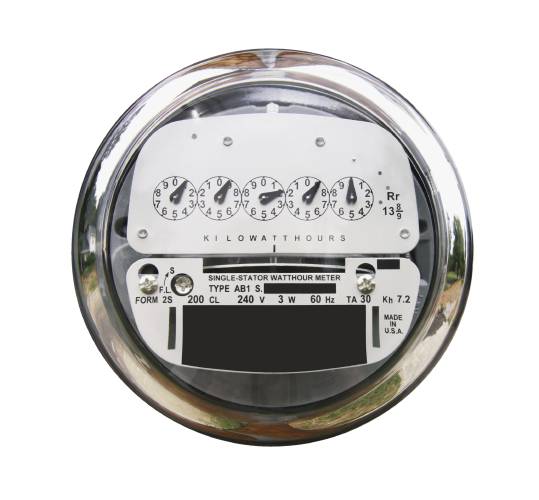Lower natural gas prices all over the world drive down NH electrical rates

Electric Meter with clipping path epantha
| Published: 12-17-2023 12:53 AM |
When it comes to our electric bills, sometimes global fuel trends giveth and sometimes they taketh away. Right now they’re giving.
Eversource on Thursday said it has asked state regulators to cut its energy supply rate as part of the twice-yearly adjustment, a move that would save customers about 15% beginning Feb. 1, while Unitil has already gotten permission to lower its supply rates about 10% compared to current bills. The reduction is even sharper compared to the bills last year, when rates skyrocketed.
New Hampshire Electric Co-Operative, which isn’t a regulated utility, is likely to see reductions when their rates get finalized later this month.
The cuts in the amount the utilities charge to provide each watt of electricity used by customers is a direct reflection of prices for natural gas, or methane, which is used in power plants that provide about half the electricity in New England. The price of methane has been low in most of 2023 and is expected to stay low partly because of record production in the U.S. and partly because of some economic issues, particularly a slowdown in China, and partly because of weather-reducing demand for heating fuel.
The story was much different a year ago when sharp rises in global methane costs in the wake of the Russian invasion of Ukraine sent New Hampshire’s electric bills skyrocketing. There’s no guarantee, of course, that they won’t skyrocket again next year, raising power bills back up.
There are two unusual aspects to the energy supply charge on electric bills.
One is that, by regulation, it is a pass-through — the utility’s charge is based solely on the price it paid to buy electricity on the open market. Cheaper fuel means utilities can buy cheaper power and we get cheaper bills.
That is one of the biggest arguments for expanding solar power: It produces very cheap electricity, to the point that in most parts of the country, it is cheaper to build a new solar plant than to keep a similar-sized coal-fired plant running. More solar on the grid means utilities could buy cheaper electricity, lowering bills even for those who don’t have solar panels.
Article continues after...
Yesterday's Most Read Articles
 Dartmouth administration faces fierce criticism over protest arrests
Dartmouth administration faces fierce criticism over protest arrests
 West Lebanon crash
West Lebanon crash
 Plan on track to ship Upper Valley mail to Connecticut for sorting
Plan on track to ship Upper Valley mail to Connecticut for sorting
 Lebanon’s Jewell back from auto accident, more aware of ‘drowsy driving’ dangers
Lebanon’s Jewell back from auto accident, more aware of ‘drowsy driving’ dangers
 Longtime employees buy West Lebanon pizzeria
Longtime employees buy West Lebanon pizzeria
The other unusual aspect is that the rates are set twice a year on a preset schedule. Utilities can’t jump in and out of the market to get lower costs.
One of the reasons that Eversource power bills rose so sharply in the past is that its rate was set at a time when natural gas prices were at or near their highest point and the rate stuck even after the price went down.
The price of natural gas was once a very regional market because it was moved in pipelines and had little international transport – unlike oil, which has long been shipped by seagoing tankers. That has changed in recent years with the increase of liquified natural gas, which can be shipped around the globe; as a result, America’s methane prices increasingly move in line with global prices just as our oil prices do. The ongoing construction of several new ports to ship liquid natural gas out of America means our price of natural gas will increasingly be dictated by world events.
Note that the decline in this year’s supply rate affects only about half of the typical residential electric bill. The rest of the bill is for distribution, which covers what each utility says are necessary costs for building and maintaining the poles, wires, towers, substations, software and other aspects of the power grid in its service area.
People who have switched to an independent service provider, buying their electricity through somebody other than their utility, still have to pay the utility’s distribution charge. And, of course, those people aren’t affected by utilities’ changes in their supply charge.
The distribution portion of power bills has been growing in recent years and is much more controversial because it depends on the utility’s claims about current and future needs.
For example on Wednesday, Dec. 13, the state Department of Energy filed a motion before the Public Utilities Commission to dismiss Liberty Utilities’ request to hike its distribution rate by $21 million over three years. The DOE said the company can’t prove its rates are “just and reasonable,” as required by law, because of changes that Liberty made to software “that impacted the company’s financial accounting.”
The distribution charge is an area where the necessary transition away from a carbon-intensive economy will cost us.
The power grid was built on the idea that electricity would come from a relatively small number of very large power plants that could mostly be turned on and off at will. Changing to a grid that can handle a huge number of often smaller power plants with varied outputs and timing will require a lot of redesign and building; expect a lot of debate over how much of that cost will be put on the distribution portion of our electric bills.

 Over Easy: On bread, buttered popcorn and big sandwiches
Over Easy: On bread, buttered popcorn and big sandwiches
